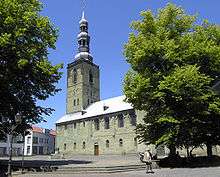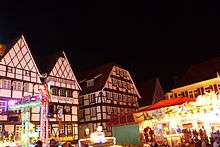Soest
Soest is a town in North Rhine-Westphalia, Germany. It used to be an important trade city during the Middle Ages and still has an outstandingly well-preserved old town with many historico-cultural sights.
Understand
Soest was first mentioned in a document dating from 836. It was located on the Hellweg, an important medieval traderoute, crossing Westphalia in a west-east direction. Soest's town charter, noted on cowhides, was a model for the municipal laws of about 70 other towns in Germany.

During the Middle Ages, Soest became one of the most important and prosperous trade places in Central Europe and a principal member of the Hanseatic League. The town's confident citizenry even tried to win their independence from the Archbishops of Cologne. This led to a five-year feud (Soester Fehde), during which an imperial ban was put on the town. The conflict ended with Soest becoming part of the Duchy of Kleve-Mark and receiving far-reaching privileges. But now it was surrounded by frontiers and cut off from its hinterland that still belonged to the Archbishops' territory. Consequently, the city lost most of its economic affluence during the following decades and centuries, the merchants' residences decayed and most citizens had to subsist on agriculture.
Under Prussian rule, Soest was made a county seat and major railway station, but—unlike most cities in the nearby Ruhr region—never developed major industries or population growth. The upside of this development (or rather lack thereof) is that the medieval townscape is mostly preserved and was not replaced by modern buildings.
Get in
The closest airport is Dortmund (40 minutes by bus and train; DTM IATA). A major airport with more international connections is in Düsseldorf (2 hours by train; DUS IATA).
Reaching Soest by train is easy, and the station is very close to the old town. Intercity trains from Weimar and Düsseldorf call several times per day; once a day, there is a direct link from Berlin, Frankfurt and Munich. There are half-hourly regional trains from Hamm and Paderborn, hourly from Dortmund. Every two hours a regional train arrives from Cologne, Düsseldorf, Duisburg and Essen.
Soest is located on the Autobahn A 44 (Dortmund – Kassel).
Get around
The old town is very compact (1.2 km from one end to the opposite). It is advisable to leave the car behind and walk, given the narrow lanes and many pedestrian zones.
The Regionalverkehr Ruhr-Lippe GmbH (RLG) operates eight local bus lines within the town (all of them connect to each other in front of the train station) and eleven regional bus lines that pass through Soest.
See


The historic old city (Altstadt) is interesting to wander about, and has a number of medieval churches and cathedrals. Most of them are built of the characteristic green sandstone that was quarried in the region.
- Remains of the medieval town fortification, including walls, moat and one of the formerly ten gates
- Burghof. Renaissance patrician house made from green sandstone, built in 1559/60, hosts a museum of town history; next to it is a Romanesque building dating from 1180, the oldest residential building of the wider region.
- Pilgrimhaus. Ancient inn, founded in 1304 – oldest inn in Westphalia
- Rathaus. Baroque town hall
- St. Peter's Church (Alde Kerke). Consecrated in 1150, it is the town's oldest church. A predecessor building had already existed in 800.
- St. Patroclus' Cathedral (Patroklidom). Romanesque-style basilica
- St. Mary on the Meadow (Wiesenkirche). Perfectly structured Gothic hall church
- St. Mary on the Hill (Hohnekirche). Romano-Gothic hall church (one of the oldest hall churches in Westphalia)
- St. Paul's Church. Gothic hall church with three bays
- Old St. Thomas' Church (Alt St. Thomae, or "Schiefer Turm"). Early Gothic hall church, known for its leaning tower.
- Big pond in the middle of the old town with historical watermill and big seesaw that was used to plunge culprits in old times.
Do

During the week around All Saints' Day, Soest is in a "state of exception". In five days, the town of 50,000 inhabitants receives one million visitors for its annual Allerheiligenkirmes (kermess)—Europe's biggest funfair held in an old town (rather than on a separate site outside the town). The whole old town is transformed into a funfair area, hosting around 400 attractions, rides and stalls. Starts on Wednesday after All Saints', ends on Sunday.
Buy
Eat
Local specialties include Pumpernickel—a heavy, slightly sweet rye bread, which is common all over Westphalia, but Soest claims to be the place of its invention; and Möpkenbrot—a coarse cooked sausage, made from bacon, pig's head, pork rind, blood and rye grist.
Drink
A local brewery, Brauhaus Zwiebel. produces and serves pale, dark and wheat beer.
Bullenauge ("bull's eye") is a coffee liquor topped with a dash of cream. It is typically drunk during kermess. Dudelmann is a cordial that is exclusively served during kermess season. Beekeeper Amelunxen's mead and honey liquor are typically associated with a visit to the All Saints' funfair, as well.
Sleep
- Hotel Stadt Soest, Brüder Straße 50, ☎ +49 2921 3622-0, +49 2921 1811. A pleasant place to stay and is very close to the railway station. It is in the old city. Double room for € 80–95.
Connect
Nearby
- Möhnesee (Moehne dam). The dam wall was breached during the second World War by RAF bombers in Operation Chastise, resulting in a huge floodwave that killed more than 1000 people (mostly foreign forced labourers). Nevertheless, the reservoir and its surrounding are a popular recreation area.
Go next
- Hamm, 25 km to the northwest (15 minutes by train)
- Meschede, 37 km to the southeast
- Paderborn, 50 km to the northeast (half an hour by train)
- Dortmund, 50 km to the west (40 minutes by train)
- Gütersloh, 50 km to the north (one hour by train)